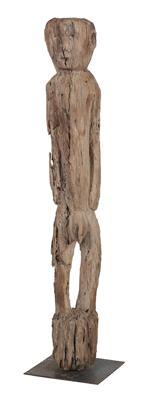Bongo or Belanda, South Sudan: a standing, male funerary figure in ‘naturalistic style’. Very rare and old.
Bongo or Belanda, South Sudan: a standing, male funerary figure in ‘naturalistic style’. Very rare and old.

The Bongo and Balanda people are cattlemen, hunters and gatherers in south-west Sudan. Their artistic testimonia are funerary steles, which are erected about a year after the death of an important tribal member. With solemn ceremonies, large stone settings are piled up over the grave of the deceased, and such memorial figures are placed on them and anchored to them. There are two types of the funerary steles of the Bongo and Balanda.
1: The most common type are simple wooden posts, into which disc-form, round subdivisions are incised. These ‘discs’ symbolise the possession of cattle and the ‘profit feasts’ that the deceased has organised for the community. These funerary steles are generally crowned with a stylised head only at the top.
2: Complete figures, such as the present one, constitute the rarer type of funerary steles of the Bongo and Balanda. This type of the complete figures is also called the ‘naturalistic-figural type’. Carved out of very hard wood, from a single trunk: the head is represented as distinct, with small slanted eyes, a flat nose, rectangular mouth and round ears, set close to the head on both sides. On the head at the top a hollowed cavity (for sacrificial offering?) is preserved. The arms lie close to the slender, proportionally elongated body, the genitals are accentuated, and the legs are straight and stand firmly (without feet) on a round plinth, which was anchored into the stone layer on the grave. An interesting, old and rare object, with heavy traces of weathering and cracks, especially on its right side. This is because the funerary figures of the Bongo stand outdoors for many years, always exposed to the wind and weather. Height: c. 90 cm; width: c. 14 cm. Between c. 1900 and the early 20th century.
Provenance:
According to information from the consignor, it was collected at the site of origin by her grandfather, a hydraulic engineer who worked in Africa since the late 1940s, and brought home. Since then: Austrian private collection. (ME)
Lit.:
‘Die Kunst des schwarzen Afrika’ by Kerchache, Paudrat, Stephan, ill. 790, 791; ‘African Art in American Collections’ by Robbins & Nooter, ill. 1300; ‘Encyclopedia of African Art and Culture’ by K.-F. Schaedler, ill. p. 114.
Expert: Prof. Erwin Melchardt
 Prof. Erwin Melchardt
Prof. Erwin Melchardt
+43-1-515 60-465
erwin.melchardt@dorotheum.at
20.02.2017 - 14:00
- Dosažená cena: **
-
EUR 1.000,-
- Vyvolávací cena:
-
EUR 800,-
Bongo or Belanda, South Sudan: a standing, male funerary figure in ‘naturalistic style’. Very rare and old.
The Bongo and Balanda people are cattlemen, hunters and gatherers in south-west Sudan. Their artistic testimonia are funerary steles, which are erected about a year after the death of an important tribal member. With solemn ceremonies, large stone settings are piled up over the grave of the deceased, and such memorial figures are placed on them and anchored to them. There are two types of the funerary steles of the Bongo and Balanda.
1: The most common type are simple wooden posts, into which disc-form, round subdivisions are incised. These ‘discs’ symbolise the possession of cattle and the ‘profit feasts’ that the deceased has organised for the community. These funerary steles are generally crowned with a stylised head only at the top.
2: Complete figures, such as the present one, constitute the rarer type of funerary steles of the Bongo and Balanda. This type of the complete figures is also called the ‘naturalistic-figural type’. Carved out of very hard wood, from a single trunk: the head is represented as distinct, with small slanted eyes, a flat nose, rectangular mouth and round ears, set close to the head on both sides. On the head at the top a hollowed cavity (for sacrificial offering?) is preserved. The arms lie close to the slender, proportionally elongated body, the genitals are accentuated, and the legs are straight and stand firmly (without feet) on a round plinth, which was anchored into the stone layer on the grave. An interesting, old and rare object, with heavy traces of weathering and cracks, especially on its right side. This is because the funerary figures of the Bongo stand outdoors for many years, always exposed to the wind and weather. Height: c. 90 cm; width: c. 14 cm. Between c. 1900 and the early 20th century.
Provenance:
According to information from the consignor, it was collected at the site of origin by her grandfather, a hydraulic engineer who worked in Africa since the late 1940s, and brought home. Since then: Austrian private collection. (ME)
Lit.:
‘Die Kunst des schwarzen Afrika’ by Kerchache, Paudrat, Stephan, ill. 790, 791; ‘African Art in American Collections’ by Robbins & Nooter, ill. 1300; ‘Encyclopedia of African Art and Culture’ by K.-F. Schaedler, ill. p. 114.
Expert: Prof. Erwin Melchardt
 Prof. Erwin Melchardt
Prof. Erwin Melchardt
+43-1-515 60-465
erwin.melchardt@dorotheum.at
|
Horká linka kupujících
Po-Pá: 10.00 - 17.00
kundendienst@dorotheum.at +43 1 515 60 200 |
| Aukce: | Mimoevropské a domorodé umění |
| Typ aukce: | Salónní aukce |
| Datum: | 20.02.2017 - 14:00 |
| Místo konání aukce: | Wien | Palais Dorotheum |
| Prohlídka: | 11.02. - 20.02.2017 |
** Kupní cena vč. poplatku kupujícího a DPH
Není již možné podávat příkazy ke koupi přes internet. Aukce se právě připravuje resp. byla již uskutečněna.
